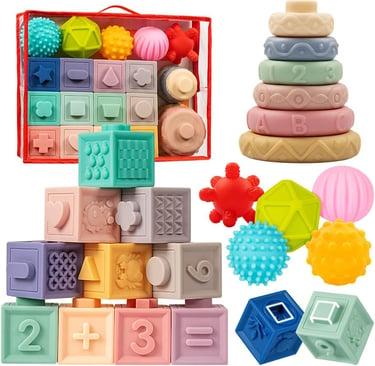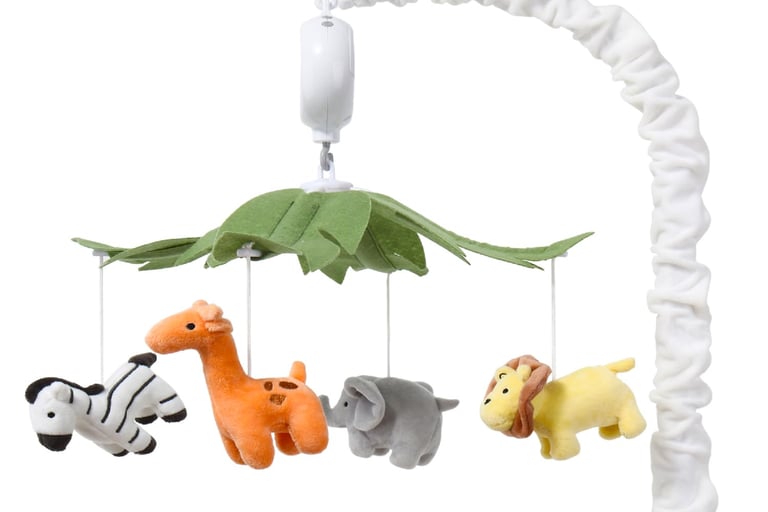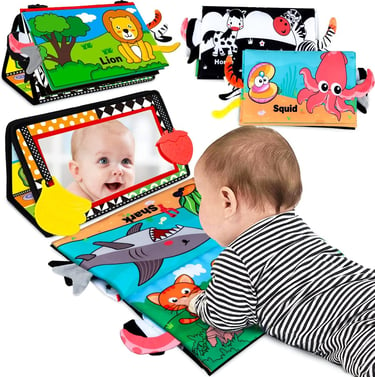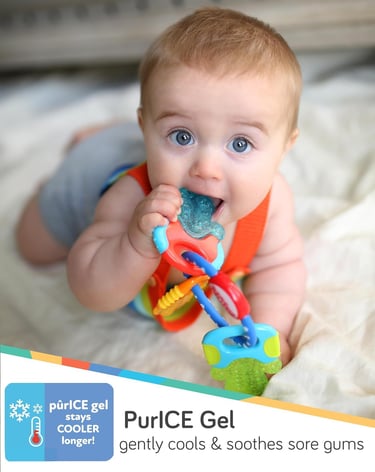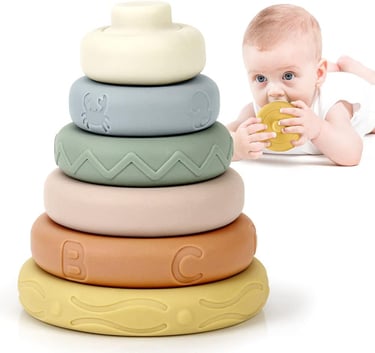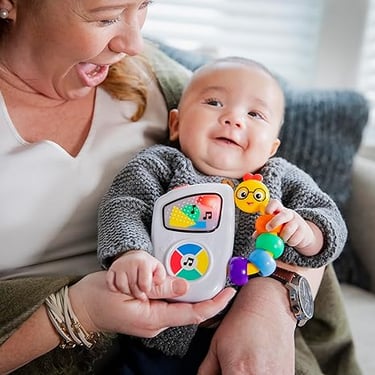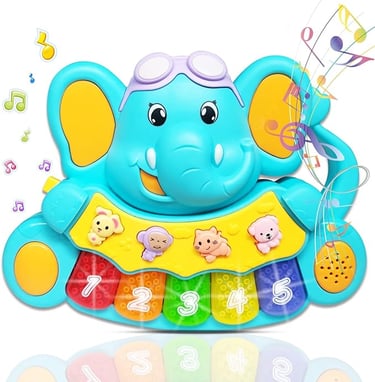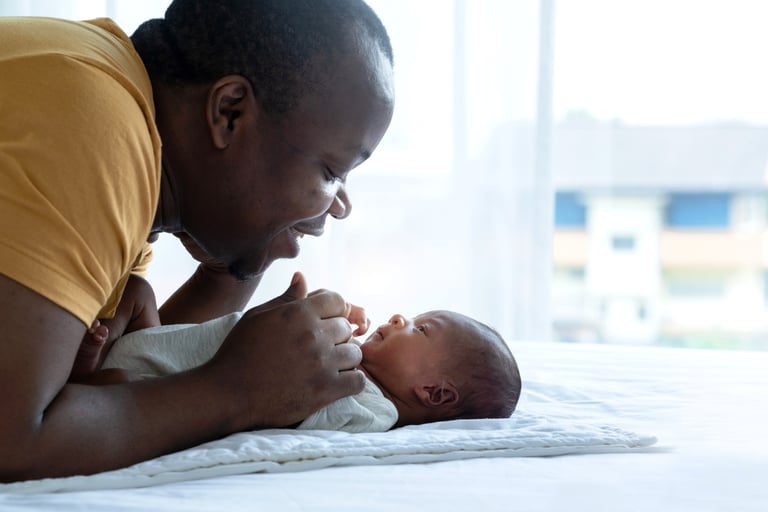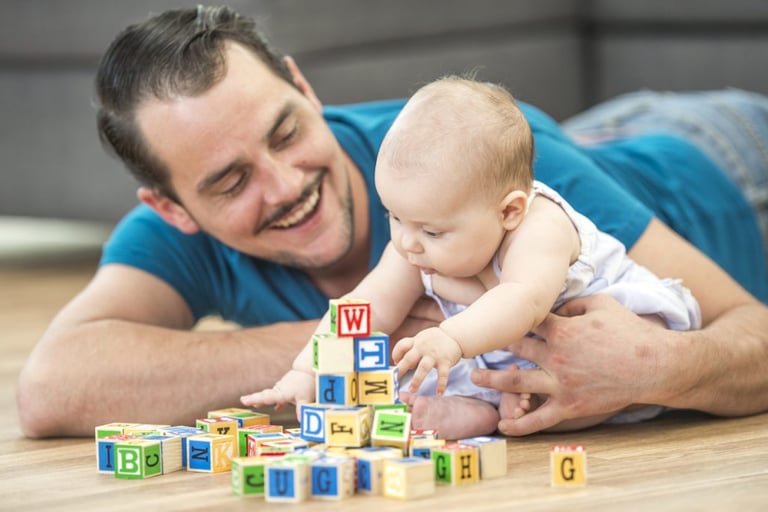How Learning Toys Help Boost Development and Help Newborns Learn
Uncover the benefits of learning toys for newborns! Learn how they enhance sensory skills and support early brain development. Check it out now!
LEARNING TOYS
Emily Harper
1/22/202515 min read
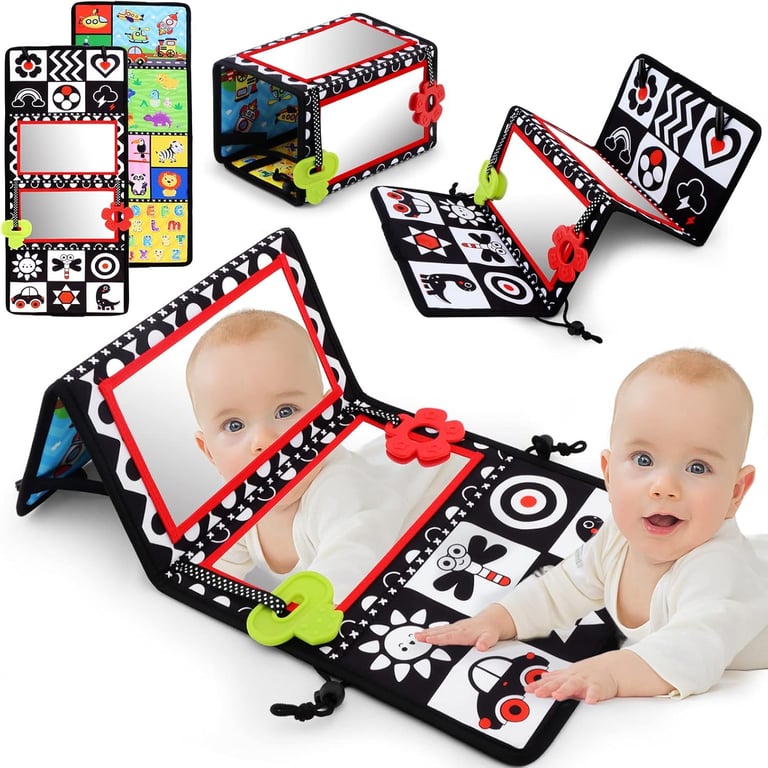

Did you know that 90% of a baby’s brain develops by age 5? Start early with learning toys!
Introduction:
The first year of a baby's life is crucial for brain development. During this time, neural connections form at an astonishing rate. As parents and caregivers, understanding how to support this growth is essential. Learning toys play a key role in this process. They are much more than just fun distractions; they ignite curiosity, stimulate senses, and help achieve early milestones. This post will explore the science behind learning toys and highlight their importance for newborn development.
What Are Learning Toys for Newborns?
When we talk about learning toys for newborns, we’re referring to toys designed specifically to support a baby’s development during their earliest and most critical growth stages. These toys aren’t just for fun; they serve as tools to help babies explore the world around them while building essential skills. Unlike regular toys, learning toys are carefully designed to stimulate sensory exploration, motor skills, and even early cognitive development.
Take rattles, for example. At first glance, they may seem like simple noise-makers, but they provide much more. For a newborn, rattles help with developing auditory skills as they listen to the sound. They also promote hand-eye coordination as babies try to reach for the rattle and improve fine motor skills when they grab and shake it. Another example is soft books that feature different textures and high-contrast colors, encouraging babies to track visually and explore with their hands.
Now, consider a generic plush toy. While it may be soft and comforting, it doesn’t engage the senses in the same way. Learning toys are intentionally designed to include various elements like textures, sounds, and movements that stimulate specific areas of a newborn’s developing brain. For instance, textured balls not only encourage babies to grip them but also provide different sensory feedback when squeezed, rolled, or mouthed.
What makes learning toys stand out is their alignment with a newborn’s developmental needs. Babies are naturally curious, even if they can't express it yet, and learning toys cater to that curiosity. These toys help babies engage with their environment while supporting key developmental milestones. For example, mobiles help babies focus visually, and tummy-time mats promote upper body strength and coordination.
Ultimately, learning toys are different from regular toys in that they’re designed with a specific purpose—to enhance sensory, cognitive, and motor development. These toys help babies learn through interaction, discovery, and play, laying the foundation for future growth.
If you want to introduce learning toys to a newborn, start simple. Look for toys that engage multiple senses and are appropriate for their age. Sometimes, the simplest toys can have the biggest impact on your baby’s development!
Sensory Stimulation: A Key to Growth
Newborns experience the world primarily through their senses, making sensory stimulation an essential part of their early development. Toys that engage multiple senses—such as touch, sight, and hearing—not only capture a baby’s attention but also play a significant role in building cognitive, emotional, and physical skills during these critical stages of growth.
How Sensory Toys Enhance Development
Toys designed with various textures, vibrant colors, and sounds provide sensory input that helps babies make sense of their world. For example, a soft block with crinkly fabric introduces contrasting textures, prompting babies to explore with their sense of touch. A high-contrast crib mobile grabs their attention and supports visual tracking, helping babies improve focus. Meanwhile, a soft tambourine or musical instrument fosters auditory development as babies begin to differentiate sounds.
These sensory experiences go beyond just fun—they help shape the brain. Sensory play strengthens neural pathways, supporting memory, attention, and problem-solving skills. For instance, when a baby shakes a textured rattle and hears a sound, they start to understand the cause-and-effect relationship, laying the foundation for more complex cognitive skills.
The Link Between Sensory Play and Problem-Solving
Sensory toys also foster curiosity, encouraging babies to explore their surroundings and solve simple problems. Picture a baby holding a textured ball for the first time. They might experiment by squeezing it, feeling its surface, or trying to roll it. Each interaction helps them understand their abilities and how objects behave in the world.
As babies engage with sensory toys, their motor skills improve, too. Playing with different shapes and textures fine-tunes hand-eye coordination and dexterity, offering physical feedback that helps babies experiment, adapt, and develop problem-solving skills. These foundational abilities will support their development as they grow.
Examples of Sensory Toys for Newborns
Crib Mobiles: High-contrast or colorful mobiles capture a baby’s attention and help with visual tracking, encouraging focus and concentration.
Soft Blocks: Blocks with varying textures (smooth fabric or bumpy ridges) promote tactile exploration and enhance grasping skills.
Musical Instruments: Soft rattles, tambourines, or squeeze toys help newborns develop auditory recognition while supporting the grasp reflex.
Tummy-Time Mats: These mats offer a multisensory experience with different textures, mirrors, and hanging toys, promoting motor development and strengthening muscles.
Introducing sensory toys to your newborn early on is not just about providing entertainment; it's about helping them make sense of their environment. These toys support neural development and contribute to building the skills they will need to thrive as they grow.
Why Sensory Stimulation Matters
Sensory play is incredibly versatile, engaging multiple developmental areas simultaneously—cognitive, physical, and emotional. A seemingly simple toy, like one that is colorful, textured, and makes noise, can serve as a gateway to a newborn’s understanding of their world. Through grasping, exploring, and reacting to these toys, babies are laying the groundwork for crucial skills such as problem-solving, communication, and independence.
When selecting toys for sensory stimulation, look for ones that combine various elements. A rattle with texture, or a mobile that moves and makes sound, provides a richer sensory experience. These types of toys allow babies to grow and develop through every playful interaction.
Motor Skill Development Through Play
Motor skills are essential for a child’s growth and independence. They allow babies to move and control their bodies, and play is the most effective way to develop these skills. Through activities like grasping, reaching, and tummy time, babies build both fine and gross motor skills, which are crucial for reaching major milestones later in life.
The Importance of Grasping, Reaching, and Tummy Time
Grasping: Newborns have a grasp reflex, but as they grow, this instinctive action turns into intentional control. Grasping toys like rattles or teething rings helps develop muscle strength in their hands and fingers, providing the foundation for fine motor skills, such as writing or tying shoes.
Reaching: Reaching teaches babies spatial awareness and coordination. By reaching for a toy on an activity gym, babies practice judging distance, focusing their vision, and controlling their arm movements—skills that are crucial for crawling and future mobility.
Tummy Time: Spending time on their stomachs builds strength in a baby’s neck, shoulders, and arms. This upper body strength is key to gross motor skills like rolling over, sitting up, and walking. To make tummy time engaging, use mirrors or textured mats to stimulate both physical and sensory development.
How Toys Encourage Physical Coordination
Toys designed for movement and interaction play an important role in motor skill development. Examples include:
Activity Gyms: These gyms often feature hanging toys that encourage babies to reach and swat, helping to develop arm and hand coordination. Some also have kickable sections that promote leg movements.
Teething Rings: These toys encourage grasping and help strengthen the hands while also providing relief for sore gums.
Stacking Rings: As babies grow, stacking toys challenge their hand-eye coordination and problem-solving skills, promoting both fine motor development and cognitive growth.
Toys like these motivate babies to move and interact, improving their physical coordination while simultaneously supporting cognitive development, such as understanding cause-and-effect relationships (e.g., shaking a rattle to create noise).
The Link Between Fine Motor Skills and Later Milestones
The fine motor skills developed through play—such as grasping toys—are the building blocks for more complex tasks in the future, including writing, drawing, buttoning clothes, and using utensils. For example, a baby who manipulates a teething ring is unknowingly practicing the same skills they’ll use later to hold a pencil or use scissors.
These early steps in fine motor development help build confidence and coordination, enabling children to meet developmental milestones with greater ease.
Creating Opportunities for Motor Skill Development
Motor skill development occurs naturally when babies are given the right tools. To foster this growth:
Provide age-appropriate toys that encourage movement and interaction.
Incorporate tummy time into your daily routine, using engaging toys to keep your baby entertained.
Offer toys of various shapes, sizes, and textures to help develop both fine and gross motor skills.
By offering opportunities for motor skill development through play, you're equipping your baby with the confidence and ability to explore the world, reach milestones, and face new challenges. From their first grasp to their first steps, every moment of play contributes to growth and independence.
Cognitive Benefits of Learning Toys
Learning toys are invaluable tools for fostering early cognitive development. These toys engage babies' minds through interaction, repetition, and exploration, promoting critical skills like problem-solving, memory, and focus. The right toys help newborns make sense of their surroundings while building a foundation for lifelong learning.
Interactive Toys and Cause-and-Effect Learning
One of the fundamental cognitive lessons babies learn is cause and effect. Interactive toys, such as light-up buttons or rattles, are ideal for teaching this concept. For example, when a baby presses a button and it lights up or plays a sound, they quickly learn that their actions have predictable consequences. This simple discovery is a major cognitive leap, helping babies understand how they can influence their environment.
These toys also encourage exploration and experimentation. A baby might press the same button multiple times to see the result or try pressing it in different ways. This kind of play sparks curiosity, reinforces patterns, and builds early problem-solving skills.
Promoting Attention Span and Problem-Solving
Newborns typically have short attention spans, but learning toys can help extend their focus over time. Toys like stacking rings or simple puzzles capture a baby's attention while gently challenging their minds. These toys encourage babies to concentrate as they work toward a goal, such as fitting a piece into the correct slot or stacking rings in the right order.
Problem-solving toys build perseverance, too. Babies learn to try different approaches until they succeed, fostering resilience and creativity. Over time, this type of play shapes their ability to tackle more complex challenges as they grow. For instance, a baby playing with a shape sorter may first try to shove all shapes into one opening. As they experiment, they learn to match shapes with the corresponding holes, developing spatial awareness and critical thinking.
Repetition and Reinforcement: Building Memory
Babies thrive on repetition, as it helps them recognize patterns and form long-term memories. When a baby repeatedly stacks blocks or presses the same button, they are reinforcing neural connections in their brain. This repetition makes it easier for them to recall actions and concepts, building the foundation for future learning.
For example, a toy that plays a tune when a button is pressed not only teaches cause and effect but also helps babies remember sequences. As babies begin to anticipate the sound before pressing the button, it shows how memory and prediction work together.
Examples of Toys That Boost Cognitive Development
Light-Up and Musical Toys: These toys teach cause and effect while captivating babies' attention with engaging lights and sounds.
Stacking Rings: A classic toy that improves problem-solving, fine motor skills, and an understanding of size and order.
Shape Sorters: These challenge spatial awareness and critical thinking by encouraging babies to match shapes with corresponding holes.
Soft Puzzles: Early puzzles designed to help babies develop focus, memory, and problem-solving abilities.
Why Learning Toys Are Essential for Cognitive Growth
Every interaction with a learning toy offers a baby an opportunity to develop their brain. Whether they are pressing buttons, stacking blocks, or matching shapes, they are building skills that will support both academic and personal success in the future.
To maximize the cognitive benefits, choose toys that match your baby’s developmental stage while offering a balance of fun and challenge. Every light-up button or stacking ring does more than entertain—it's an investment in their curiosity and future learning.
Emotional and Social Development
Playtime plays a vital role in emotional and social growth during a baby’s early years. It’s not just about fun—it’s an opportunity for babies to begin forming connections, learning social cues, and gaining emotional awareness. Toys designed for interaction are powerful tools that support these developmental milestones, helping babies recognize faces, voices, and emotions, and fostering bonding with caregivers. These early experiences lay the groundwork for a child’s ability to understand themselves and connect with others.
Recognizing Faces, Voices, and Emotions
From birth, babies are wired to seek connection. Toys with human-like faces, such as dolls or plush toys with embroidered eyes and smiles, help babies begin recognizing facial features. Over time, babies learn to associate these features with different emotions, distinguishing between happy and sad expressions.
Sound-based toys, like those that play familiar songs or mimic voices, also assist in emotional development. For example, a lullaby can create a calming effect, while a cheerful song brings joy. These sensory experiences are crucial for developing emotional awareness and communication skills.
Mirror toys are another excellent option, as babies are fascinated by their reflections. This simple experience helps babies recognize themselves, marking an important milestone in self-awareness and emotional development.
Encouraging Bonding During Playtime
Playtime provides a valuable opportunity for caregivers to bond with their babies. Toys that require shared play, like rolling a ball back and forth or using plush puppets for interactive storytelling, encourage moments of connection.
When a caregiver engages with a baby, they’re not just entertaining—their actions model positive social behaviors. Eye contact, gentle conversation, and laughter during playtime help babies learn how to interact with others. These interactions form the foundation of empathy and communication skills, teaching babies how to respond to social cues.
Toys that encourage cooperative play also strengthen the caregiver-child bond by allowing parents or guardians to tune into their baby’s emotions and needs.
Building Self-Confidence Through Play
Every time a baby successfully interacts with a toy, they experience a sense of accomplishment, which builds self-confidence. Whether it’s grasping a rattle, stacking a block, or pressing a button to make a toy light up, these small victories encourage babies to explore their environment and grow more independent.
For example, when a baby figures out how to make a toy produce sound by pressing a button, they learn that their actions influence the world around them. This realization builds autonomy and self-assurance, laying the groundwork for overcoming more complex challenges later in life.
Repetition also helps foster self-confidence. When babies can perform an action repeatedly with success, they feel a sense of mastery. This confidence drives them to explore new activities and toys, further developing their emotional and social abilities.
Toys That Support Emotional and Social Development
Soft Dolls or Stuffed Animals: Help babies recognize faces and associate emotions with facial expressions.
Mirror Toys: Encourage self-awareness and emotional recognition through reflection.
Musical Toys: Reinforce auditory cues and emotional responses, from calming lullabies to cheerful melodies.
Interactive Toys for Shared Play: Puppets, balls, or storytelling books promote bonding and teach social cues.
Why Emotional and Social Development Matters
Emotional and social growth during the early years is critical for a baby’s ability to navigate relationships and express themselves throughout life. Toys that encourage recognition, bonding, and confidence-building play a pivotal role in this process.
By incorporating emotionally engaging and interactive toys into your baby’s routine, you’re fostering not only their joy but also equipping them with essential tools to thrive socially and emotionally as they grow. These simple, joyful moments of play will become stepping stones to deeper connections and a strong sense of self.
Choosing the Right Learning Toys for Newborns
Selecting the right learning toys for your newborn can seem overwhelming, but focusing on safety, developmental appropriateness, and versatility will make the process easier and more effective. The right toys not only entertain but also support your baby’s growth and learning at each developmental stage.
Safety First: Non-Toxic, Soft, and Age-Appropriate Designs
Safety should always be your top priority when choosing toys for newborns. Babies tend to explore the world with their mouths, so it’s crucial that the toys are made from non-toxic materials. Look for certifications like "BPA-free," "phthalate-free," and "ASTM-certified" to ensure the toy meets safety standards.
Soft toys are ideal for newborns, as they are gentle on sensitive skin and pose less risk of injury. Plush animals, fabric books, or textured cloth balls are easy for little hands to grasp and cuddle. Additionally, avoid small toys that can fit into your baby's mouth, as they may pose a choking hazard. A good rule of thumb is to choose toys larger than a ping-pong ball.
Toys for Various Developmental Stages
As your baby grows, their needs and abilities will change rapidly. Here's a guide to help you select toys for each developmental stage:
0-3 Months: Focus on sensory stimulation. High-contrast toys, such as black-and-white mobiles or soft rattles, will capture your baby’s limited visual range.
3-6 Months: During this stage, babies begin to explore textures and practice grasping. Textured teething rings, activity mats, and crinkle toys are excellent for tactile development.
6-12 Months: As babies become more mobile, toys like soft blocks, stacking rings, and musical instruments encourage active play and the development of fine motor skills.
Choose toys designed to evolve with your baby’s needs, such as activity gyms that support tummy time and later encourage sitting play.
Tips for Selecting Versatile and Budget-Friendly Options
Rather than buying all the newest toys, aim for a curated collection of high-quality, versatile toys. Here are some tips for selecting the best ones:
Go for Multifunctionality: Choose toys that serve multiple purposes, such as a rattle that doubles as a teething ring or an activity mat with removable sensory elements.
Invest in Durability: Select well-made toys that can withstand wear and tear. These will last longer and can be passed down to siblings or reused.
Stick to Essentials: A few well-chosen toys, such as a soft plushie, a sensory book, and a rattle, can fulfill most of your baby’s needs without overwhelming them.
Consider Secondhand Options: Gently used toys can be an affordable way to expand your collection. Just be sure to sanitize them thoroughly and check for recalls.
Where to Find Great Learning Toys
Several brands specialize in safe, developmentally appropriate toys for newborns, including Lovevery, Hape, and Manhattan Toy. You can also find excellent choices at budget-friendly retailers like IKEA or through online marketplaces offering curated newborn toy kits.
Why Thoughtful Toy Selection Matters
The toys you choose for your newborn play a crucial role in their development. By focusing on safety, developmental appropriateness, and versatility, you can create a stimulating environment that nurtures your baby's growth while being mindful of your budget. The right toys not only entertain but also foster essential cognitive, emotional, and motor development, helping your baby take their first steps in the world.
The Role of Caregiver Interaction in Toy Effectiveness
While learning toys are essential for your baby’s development, their impact is enhanced when caregivers actively engage with them during playtime. Guided play, talking, singing, and direct interaction help unlock the full potential of each toy, turning it into a dynamic learning experience.
How Guided Play Enhances the Benefits of Learning Toys
Guided play involves caregivers intentionally engaging with babies to explore toys and help them understand their features. For example, shaking a rattle, drawing the baby’s attention to the sound, and placing it in their hand turns a simple toy into a tool for sensory and motor development.
Through guided play, babies are encouraged to focus, observe, and interact more deeply with their toys, leading to more effective brain stimulation. These interactions also foster trust, which is foundational for emotional well-being.
The Importance of Talking, Singing, and Interacting During Playtime
Babies thrive on interaction. Even if they don’t fully understand the words, hearing your voice helps develop language skills. Here are ways to integrate more interaction into playtime:
Talking: Use descriptive language to label colors, shapes, and sounds. For example, “This is a red ball. Can you feel how soft it is?”
Singing: Singing songs with actions, such as “Itsy Bitsy Spider,” encourages babies to connect sounds with movements, making the experience more engaging.
Interacting: Simple gestures, like offering a toy or waiting for your baby to reach for it, help build early communication skills.
The warmth and tone of your voice create a comforting environment where your baby feels safe and encouraged to explore.
Activities Caregivers Can Do With Toys to Maximize Impact
Maximizing the effectiveness of learning toys doesn’t require elaborate setups. Here are some examples of activities that blend toys and caregiver interaction:
Sensory Play: Use textured toys like soft blocks or crinkle books to introduce new sensations. Guide your baby’s hand across the surface while describing what they’re feeling: “This side is smooth, and this side is bumpy.”
Cause and Effect: Show your baby how interactive toys work, such as pressing a button to make a toy play a tune. Then encourage them to try it themselves.
Tummy Time Games: Use an activity mat or toy with a mirror during tummy time. Lie next to your baby, point to the objects, and cheer them on as they reach or lift their head.
Simple Hide-and-Seek: Play peekaboo with a soft toy, partially hiding it under a blanket. This activity helps babies develop object permanence while being fun.
Why Caregiver Interaction Matters
Ultimately, caregiver interaction is what transforms playtime into a learning experience. Babies learn best in the context of warm, responsive interactions, which make them feel safe and valued. When caregivers engage with their babies, they lay the foundation for curiosity, communication, and confidence—skills that will serve the baby throughout their life.
So, pick up your baby’s favorite toy, get down on the floor, and enjoy these precious moments together. Every giggle, smile, and “aha” moment is a step forward in your baby’s bright future!
Conclusion:
Learning toys are vital for your baby's growth. They enhance sensory skills and strengthen emotional connections, laying a solid foundation for future development. Choose toys that match your baby’s stage, ensuring they bring joy and stimulate curiosity. By selecting the right learning tools, you empower your child to explore and discover. Start today and watch as your little one blooms through play. Invest in their future with toys that teach and inspire.

